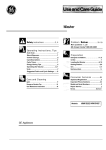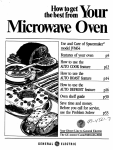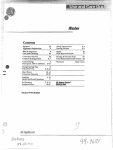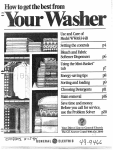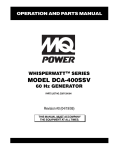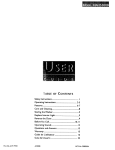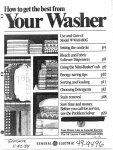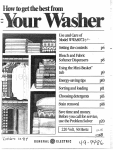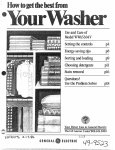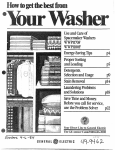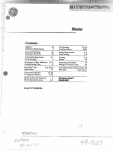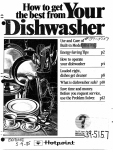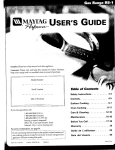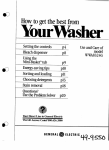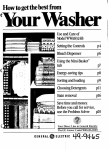Download GE WWA8310B User's Manual
Transcript
. -. togetthebestfrom use andcare of Model mA8310B SettigtheControk p4i Ener~-satigtips p6 Sorthgandloatig p7 Choosing detergents p9 p14 Stainremoval Savetimeandmonew Beforeyoucd for usetheProblem Solver p18 siwice, Your Direct he toGeneral Electric TheGEAnsIverCenteF800e626e200 Help us help you. , safety hlstrlmic?m 3“4 setting the controls ’445 Hmv to usesoak setting 6 Energy saving Tips Good Sorting Means Better Vv--hing It Pays to Chxki and ‘ Pm-tr’eat EkNvlb Load Your washqr What is the Best,size Load’ ofcMWs? ‘b -- “ ““. 6 ‘7’ ‘7 ~ . ., $ 8 J c1 Read this use and‘cam Bookcarefully R willhelp you operate and maintain your newwasher properly. write &Fw’B3 the MMMM Wd semi! numbers. You’llfind them on a label on the lower left sidenear the front. ~ These numbers are also on the Consumer Product Ownership RegistrationCard that came with your washer. Before sendingin If you don’t understand something this card, pleasewrite these or need more help...CaU,toll free: numbers here: The GE Answer ‘c%mterT~ 800.626.2000 Model No. COllmmker Mm-nation Mm&x! or write (includeyour phone number): SerialNo. ConsumerAffairs Use these numbers in any General ElectricCompany correspondenceor servicecalls AppliancePark concerningyour washer. Louisville,KY40225 H you nwwiveda! dmlaged washer, immediatelycontact the dealer (or builder) that sold you the washer. Keep it handy for answersto your questions. save time and money. Mm%!you CMm’ Mm&x! Check the Problem Solver(pages 18-23).It listsminor causesof operating problems that you can correct yourself. It could saveyou an unnecessaryservicecaL e. Hard Water—Do You “ , ,n ‘ .‘ ‘ ~ave’ It? . ‘. , , .’“ ~., . . ~, Other Lautidryj?@h.&s 1~”’,:,,’ How To Renicwestains“1445 ‘‘. Washing (hide 16-1’7 “ Different Fabrics and IAMik “-“ ‘fpi. The Problem Solver How To Care for -four washer - 18-23 2’4 Consl-umxservices 27 Warranty E@Jkcm%%’ FOR YOURSAFETY 2 - . —. ...— .....-“ ... Important SafetyInstructions–sAvE THESEINSTRUCTIONS Read auinstructions before using this appliance ?VARNING—When usingthis appliance,alwaysexercisebasic safety precautions, includingthe following: e LJsethis apphm? only forits intended purpose as describedin this Use and Care Book. @Thiswasher must be propedy installed and located in fmordanw with the Installation Instructions before it is used. If you did *notreceivean Installation InstructIonssheet with your washer,you can obtain one by contactingthe servicelocation nearest you. - Properly ground to conform with all governingcodes and ordinances. - Install or store where it willnot be exposedto temperatures below freezingor exposedto the weather. _ - Connect to a properly rated, protected and sizedpowersupply circuitto avoid electrical overload. - Connect to adequate plumbing and drain facilitiesas described in the Installation Instructions. @Turn off water faucets when the washeris not in use to relieve pressureon hosesand valves,and to minimizeleakageif a hose or valveshould break or rupture. ~ When disconnectingthis appliancepull by the plug rather [ban the cord to avoid damage to the cord or junction of cord and pkg. Make sure that the cord is located so that it willnot be stepped on, tripped over or otherwisesubjected to damage or stress. — --— ~ We stronglyrecommendthat any servicingbe performed by a qualifiedindividual. ~ The wiringdiagram for this machineis located insidethe control paneL electricalappliancewhichis connected to the hot water system. This willallowany hydrogengas to escape. Of course, sincethe gas is flammable, do not smoke or use an open flame or applianceduring this process. ‘r-ominimize the possumy of injury: UIDo not mix chlorinebleachwith ammonia or acids such as vinegar and/or rust remover.Mixingcan produce a toxicgas whichmay cause death. * Never reach into the washer whileit is moving. Beforeloading, unloading or adding clothes, push in the CycleSelectorknob to “STOP” position, then wait until the machinehas completely stopped before openingthe lid. @Do not wash or dry articlesthat have been cleanedin, washedin, soaked in, or spotted with combustibleor explosive substances(such as gasoline, degreasers,dry-cleaningsolvents, kerosene, etc.) whichmay giveoff vapors that could igniteor explode. Do not add these substancesto the wash water. @Closesupervisionis necessary if this applianceis used by or near children. Do not allowchildrento play inside, on, or with this appliance or any discardedappliance. Disposeof discardedappliances and shippingor packingmaterials properly. Beforediscardinga washer or removingfrom service, remove the washer lid. Do not use these substances around your washer and/or dryer during operation. @HYDROGEN GAS is produced by the chemicalaction withinyour water heater and the gas can accumulatein the water heater and/or water pipes if hot water has not been used for a period of two weeksor longer.HYDROGEN GAS CAN BE EXPLOSIVE UNDER THESE CH?CLJMSTANCES.So to preventthe possibilityof damage or injury,if you have not used hot water for two weeksor more, or moveinto a residencein whichthe hot water systemmay not have been used for some time, turn on all hot water faucets and allowthem to run for severalminutes before usingany @Keep all laundry aids (such as detergents, bleaches,fabric softeners, etc.) out of the reach of children, preferably in a locked cabinet. Observeall warningson container labelsto avoid personal injury. @Keep the area around and underneath your appliancesfree from the accumulation of combustible materials, such as lint, paper, rags, chemicals,etc. @Keep the floor around your appliancesclean and dry to reduce the possibility y of slipping. @To minimizethe possibilityof electricshock, unplug this appliance from the power-supplybefore attempting any maintenanceor cleaning(exceptthe removaland cleaningof the lint filter). NOTE: Turning the CycleSelectorknob to an OFF position does NOT disconnect the appliance from the power-supply. Continued on next page ---L------— -- .- — — e DO IMX tamper with controls. @Do not operate this appliance if i~is damaged, rnalfuncticming, partially disassembled,or has missingor broken parts, including a damaged cord or plug. ~ Do riot wash fiberglassarticlesin your washer.Skin irritation could result from the remainingparticles that may be picked up by clothing during subsequentwasheruse. How tooperate operation Forwasher @Do not leavewasher lid up during cycle.This willstop the wash and spin action and prevent completionof the cycle. @The laundry processcan reduce the flame retarckmcyof fabrics. To avoid such a result, the garment manufacturer’scare instructions should be followedvery carefully. $ Neverclimb on or stand on the washer top. clotheswasher your . O!F j Rs?guler Cycle Water Level ~~ Temperature NORMAL SPEED ... WARM , . “:swL@LARGc QJLoad clothesinto the wash basket being careful not to overload. Clothes should be below the retaining ring. Seepage 8 for more loading information. GENTLE SPEED “’E(I!Y,T eev.am TN ❑ Lmding @Sort clothescarefullyby fabric type, weight, color and amount of soil according to instructionson page 7. @Removel?ilter-Flo@pan. The underside of the lid is a good place to put the pan whileloading or unloading clothes. ~ @ / LIGHT SOIL )) sorting ad /“ $ SOAK.$ .\ Perm. Press S Knits Cycle “.” COLD kt50WM Autometic Two Speed Washar NORMALSOIL J % \ / ‘[F ‘“’MA” ““”~\\ A B @Position Filter-l?lopan on agitator and add measured amount of detergent. Seepages 9 through 12 for information on detergentsand other laundry additives. NOTE: Do not use the Filter-Flo pan as a wash basket. Do not put any items to be washed in the Filter-l?lopan. Seepage 13for information on how to use bleach and fabric softener. @Closelid, washer willfill but not agitate or spin with lid open. mm ❑SelectWash and Rinse Temperature. uPush CycleSelectorKnob in and turn clockwiseto your selected wash setting. Regular Q& automaticallyprovidesNormal Wash Speed and Normal Spin Speed. Perm Press& Knits Cyck? automaticallyprovides Gentle Wash Speed and Gentle Spin Speed. setting the Controis Use the Controls Setting Guide on page 5 to help you make the proper selections. ❑SelectWater Level. ❑PU1lCycleSelectorKnob out SMALL: Washer is lessthan 755full of clothes. MEDIUM: Between M and 2Afull. LARGE: Over %‘s full. to start the washer. If you.wish to changesetting after washer has started, push CycleSelector Knob in to stop the washer and reset to the new position. Setting can be changed at any time. Someadjustment to theserecommendationsmaybe desirabledependingon your particular washingconditions. PolyesterKnits Synthetics& Blends Permanent Press Cottons & Linens Fabric Work ciofhes, dungarees, etc. with heavy soil Work clothes, dungarees, etc. with normal soil White or Colorfast Bright Colors Heavy or Oily Soil Normal or Light Soil Heavy or Oily Soil Normal or Light Soil Wash/Rinse Temperature HotlCold HotlCold or Warm/Cold Hot/cold ‘r WarmlCold Warm/Cold HotlCold WarmlCold WarmlCold Warm/Cold Normal Soil Normal Soil or Light PermPress& KnitsCycle RegularCycle Cycle Selector Setting Norma! Soil— for small loads. HeavySoil—for all otherloads Normal Soil Normal or Light Soil Normal Soil Normal or Light Soil Normal Soil or Light Tips toHelp You select settings Penn. Press & Regukw‘cyck— ,NC-ASO:, /-i? Press Cycle For most cotKnits Cycle— E For Polyester tons, linens, work and play Knits, deliu @yl cates and clothes.Three # soillevelsettings permanent press. ) An extendedcoolare provided, L but you can set the selectorindown spray rinse is providedto between,if desired. Selectionof minimizethe settingof wrinkles. these settingsautomatically Selectionof these settingsautoprovidesfor Normal Wash Speed, maticallyprovidesfor Gentle Fast Spin. Speed Wash, SlowSpin. rQ OFF ~eg”,ar NQRMAL SPEED ~ ,erm. / .$ GENTLE SPEEO LIGHT/ OFF SG+L ..- Knits Cycle N2R+.W 1’ HEAW in Soak Setting— Use with most soakingaids to loosenembeddedsoilsand stains. Seepage 6. EalEz— OFF Regular /: cycle sptm * Efi%!K” _— -.. .$# ?&ii=&l ~ -- x Ea=# ius5f9- “q / LIGHT SC4L liasa W.KxW4.L1’ WAVY EiwY. m– setting (Approximate Mimdes) whatHappens Each Regular Cycle Normal Speed Wad?, Fast Spin Selector Settings Wash Spin Rinse Perm. Press & Knits Cycle Gentle Speed Wash, S1OWSpin I cycle Heavy Light Soil Normal Soak I Normal Soil m?a--- Light -1 -- 1 18 3 1/2 31/2 ~ 31/2 3’/2 101/2 6 14 I 3 Y2 31/2 I 31/2 31/’ Spin TOW! Time I 23 ‘/2 161/2 NOTES:~Total time includes pausesbetweeneach phaseof cycle. ~ Totai time does not includewater fill time. Fill times vary dependingon householdwater pressureand your selected water level. ~Rinse Starts Here +—— Spin Starts Here -— --- 5 - sw?a—— Energy-savingTips Regular Cycle NORMAL SPEED ~ “SOAK” settingtemperature willautomaticall~be c~ld. ~ If a hot or warm soak is desired9 @the WASH/RINSE TH’@ERAllJRE switchto “HOT/COLD” or” WARM/COLD” and turn the CycleSelectorKnob to “Normal” in the RegularCycle.Start the washer.After washer fillsand beginsto agitate, bush in the Cycle SelectorKnob and.turn to “SOAK? Pull out the Cycle SelectorKnob to completethe cycle. ~For an extended soak allowthe washer to fill and agitate for a few minutes to dissolvethe soaking agent. Then push in the Cycle SelectorKnob to stop the washer (keep lid closed)and allowto soak for as long as desired. After desired soak period, pull out the CycleSelectorKnob to complete the cycle. We are all consciousof the need to saveenergy—toprotect our country’senergyreservesand to help us savemoney.There are severalthingsyou can do to reduce the amount of energyneededto wash your clothes: 1, Use Hot Wash—140°(60°C)— on a regularbasisonly when washingheavilysoiled articles-such as work and play clothes. 2. Under normal soilconditions, wash in water above 80°1?(27°C). This generallymeans using the Warm Wash temperature setting on your washer—temperatures approximately95°F(35‘C). If you notice that soilhas accumulated after severalconsecutivewashings, use Hot Wash occasionally,if safe for fabrics. 3. Try to wash lessoften. Save articlesof the sametype of fabric until you have a full load. 4. If you must wash smallerloads, adjust the amount of water. Small loads should have lowerwater levels. 5. Wash in off-peak utilityhours. Yourlocal utilitycan tell you which are the off-peak hours. 6. Use your washer’sNormal Speed Spin. Youcan saveenergy on the Gentle Cycleby switching from Gentle Spin to Regular Cycle/Normal SpeedSpin. This willremovemore water during spin, which willshorten drying cycleto save more energy.The drying willremoveany wrinkles which may result from the Normal Spin. IMPORTANT NOTE: If your clothes and householditems don’t look clean and fresh after washing, what are you apt to do? Youwill probably then re-washthem ... and that means you’llwaste energy.Rememberto sort your clothes carefully,and load them properly, selectcorrect cycles,use enough detergent and choosea watertemperaturewarm enough to releaseand get rid of soil. Good sorting means better washing sortby soil Separate \n from from , Lint Collectors LINT PRODUC13RS-such as terry towelingand chenille—give up lint. LINT COLLECTORS—suchas man-made fibers and napped fabricslike velveteenand corduroy —attract lint. These must be washed separately. FOR MORE INFOWATION ON LINT CONTROL, SEE PA”GE18. e sortby fabric Separate T“3 ,* Medium Soil from soaking &Pr6?-tr’eating— agoodway to Kmsen d~~jl SOik $MldSWM3. sortby color \ Whitesj from from \3 from ● Permanent Press & Blends from from ● Synthetics & Poly Knits 13 from \.elicates/ In addition to sorting to reduce lint collection, it is recofimended that fabrics of similarconstruction be washedtogether wheneverpossible. It pays tocheekand Wfashil’ig. prepare dom?s * Empty pockets, brush out cuffs, zip zippers, snap snaps, hook hooks and button buttons. ~ Do any necessarymending— rips, hems, tears. @Check all items for areas of heavy soilor stain. ~ Removestains. FOR STAIN REMOVALCHART, SEE PAGE 14. @Turn Poly Knits inside-outto minimizefabric surface damage. for Separate FOR mJ$TRucTIoNs ON DIFFERENT FABRICS AND LOADS, SEE PAGES M mud17. A thorough soakingwith detergent or specialsoaking agent is an excellentway to removeheavy soils, embedded dirt and evensome stains. I Soakingcan be either a completely separate washingstep or a preliminary step to a completewash cycle. For detailedinformation on how to soak in your washer,pleasesee page 6. FOR INFOWATION ON SOAKING AGENTS, SEE PAGE 13. ~ I?re-treat heavy soilby rubbing in a small amount of liquid detergent or a paste made of water and powdered detergentor soap. For best results wait YZhour before washing. Speciairemmmendationsfor washingpermmentpressif you do not havea dryer. If you are machine-washing Permanent Press clothesthat you plan to hang or drip-dry,use extra care to minimizewrinklingin the wash process: @Be careful not to overload washer.Permanent Press clothes must have ample room to move freely.A MediumsizePermanent Press load is the Iargestthat should be washed. ~ Use more water than you would for a regular load. Use a Medium Water Levelfor a SmallLoad; a Large Water Levelfor a Medium Load. @Removeclothesas soon as washer stops and hang immediately. ~ Load clothesdry. ~Take a properly sorted group of clothes and drop thermlooselyin the wash basket in this order: Large Items—likesheets. Do not wrap around the agitator. SmallItems—1ikewashcloths. Medium SizeItems—1iketowels. Here is a typical full load: 3 Double Sheets 6 Long SleeveShirts 3 Boxer Shorts 6 Standard Pillow Cases 5 T-shirts 4 Pair Trousers 6 Handkerchiefs Thisillustrationwithclothesjust reachingthe ClothesRetaining Ring,showsa properload. Clothes haveampleroom to movebecause theyare not packeddown, nor wrappedaround the agitator. Clothesare loadeddry sincewet items are apt to pack down which encouragesoverloading.This size load requires a full water fill. what is the best sizeIoad of Clothes—large,medilnn9or Smali? Save time, energy and detergent by avoidingextra use of the washer.Try to wash a full load of clothes. If you can it is better to saveclothesuntil you have a full load. If you must wash smaller loads, savewater, energyand detergentby adjustingthe water levelfor the sizeof the load. See page 4. To add itemsafterthe washerhas started. @Turn off the washer. ~ Carefullyremovethe Filter-Flo pan. ~ Add any additional articlesby submergingnext to the agitator. ~ Replacethe Filter-Flo pan and restart the washer. NOTE: Do not use the Filter-Flo pan as a wash basket. Do not put any items to be washed in the Filter-l?lopan. NOTE: When washingstockings, panty hoseand other easilytangled items,alwayshandleseparately.To minimizetangling,the useof a net laundrybag is recommended. . ...._ . . . ; Disadvantages: Pm’vdwedDetergents NQn”Phosphate— PowderedDetergents Liquid Detergents Perform wellin hard or soft water. Wash all types of fabrics well. Can be used in hot, warm, or cold water. Are not availablein some areas. Perform satisfactorilyin soft or moderatelyhard water. In some areas only nonphosphate products are available. Generallydo not clean wellin hard water. May be difficult to dissolve, especiallyin cold water. Perform wellin soft water. Offer better performance in hard water than powdered non-phosphate types. Should noi be used in cold water. Those containing sodium “ carbonate as an ingredientmay cause harmful limestone deposits on clothes and washer when combined with hard water. (SeePage 12.) May not perform as wellas powdered phosphate products when diluted in wash water. Clean syntheticsand fabric blendswell. Are excellentas concentrates for removingspots. Completelydissolveevenin cold water. Perform wellin soft water. Generallydo not clean wellin medium-hard or hard water. May combine with water hardness mineralsto form sticky soap curd. 9 — .- The damagingeffects ofcarbonate Detergents on your Clothesand your washer. — u Is your water hard? Hit is, and if you use a carbonate type nonphosphate detergent, the unavoidableresult willbe limesstone*depositson your clothes and washersurfaces. DmmgetoCMhes Although limestonebuild-up occurs more rapidly on cotton, it willeventuallyaffect various fabrics in the followingways: @Givesa.stiff, harsh, rough feel to fabrics such as toweling. @Causescolors to fade and becomedull and dingy. @Causesgraying of fabrics. ~ Leavesa white, powdery residue on dark-colored items. @Causesspot-fading of bright colors as a result of direct contact with detergent. @Reduceswrinkle-resistanceof permanent-pressfabrics. @Destroyseffectivenessof flameretardant finisheson cottons such as children’ssleepwear. @Increasesfabric wear because of the scrubbingaction between limestonedeposits on the fabrics during washer agitation. The hardness of your water and your washingfrequencywill determinehow rapidlythe lirnetone willbuild up. If your water is VERYHARD (11or more grains) evenif you washjust a fewloads a week, you may seelimestone build-upsin just a fewmonths. (seePage 12). How toreduce h’mmme Humtopartially restore Ih.amhps dotht?$ Rwmlmen(.kd Methods ~ Soak clothesin a solution of 2 cups of vinegarin one gallon of hot tap-water for 15minutes. USE A PLASTIC CONTAINER. Then wash clothesin the Washerusing detergent. ~ Use a powderedphosphate detergentor a liquid detergentif these are availablein your area. @Install a home water softener. This willsignificantlyreduce limestonebuild-up. CAUTIONS @Use a packagednon-precipitating @Do not usevinegarsoak solution in washer.Theacidic action of the water softener, such as Calgon / .$ vinegarmay damagethe porcelain. with phosphate. st?wmdaryMethods The followingmethods have limitedbenefit and willonly delay temporarily the formation of the limestonedeposits. ~ Vinegarsoaksolution may reducethe wrinkle-resistanceof permanent-pressfabrics. ~Vinegarsoak may damagethe dyes in somefabrics. @Use of hotter wash water, for example 125“1?to 135“F(52°Cto 57‘C) for cottons. This also improvesoily-soilremoval. @Adding detergentand allowing washer to fill and agitate for three or four minutes to dissolve detergentbefore adding clothes. Damage to washer @Unsightlybuild-up on all washer surfaces exposed to the wash solution. ~ Mat-1ikecrusty formations caused by lint adhering to the stickylimestonedeposits. @Increased servicecallsbecauseof limestonedeposits in the pump, recirculationwater hoses, filters and other washer parts. = lled~ced useful life of washer. * LltvlESTONE-technically called CALCIUM CARBONATE–is caused by the reaction of the calcium in the hard water with the sodium carbonate in the detergent, How much detergentshould you use? The use of a sufficient amount of detergentis one of the most important things you can do to make sure your wash comes out clean. If the recommendedamount of detergentproducestoo many suds, switchto a low sudsingdetergent brand, and followinstructionson package. Amount requiredvaries accordingto: 1. Water hardness 2. Amount of soil 3. Sizeof load 4. TWe of detergent 5. Wash temperature How to use detergent Granular or Powdered—Placein the filter pan for normal conditions, but, for best results, put the detergentnext to the agitator after the clotheshavebeen loaded. If your detergentdoesn’tdissolve well,pre-dissolvethe detergentin hot water then pour directlyinto the wash basket. Use moredetergentif you have... 1. Hard water 2. Large loads 3. Greasy or oily soils 4. Lower wash temperature 5. Low phosphate detergent. Usingtoo littledetergentis a common cause of laundry problems. Alwaysmeasuredetergentin a standard measuringcup. Es3c—’— -.. -1 of for - Recommended Immlmt (ktergerht Wer’age SON bad highSudsingpowder. Water Level Setting Water Hardness High Sudsing Powder Type Large Medium Small VERY HARD 1(9-20Gr. 2 cups 1% cups 1% cups HARD 4-10 Gr’. 1% cups cups 11/2 % cup SOFT I O-4Gr. Low Sucking Concentrated Powder Type LIQUID o-1o Grains o-1o I Grains ] 1 CUP 1 cup I 1CUP % cup —, &%— W. E?m.--- 1. Use recommendedamount of detergentfor your load and water hardness as shown in chart. 2. Other detergenttypes—Low and normal suds, powders, liquids, non-phosphatepowders, follow recommendationson package. i lACUP ‘/2 cup FOLLOW PACKAGEDIRECTIONS 3. For hard water treatment, see page 12. I —1 ~ —. — Hard water—do you haveit? Before you can decidewhat to do about hard water, you need to know if you have it and, if so, how hard it is. @If you livein a municipalarea, contact your water company. @If you livein a rural area, or in some suburban areas, contact your county agent. The answer willbe “you have ‘so many grains’ per gallon” and means this: 9 to 3 grains per gallon-SOl?T, 4 to 10grains-HARD, 11to 19 grains-VERY HARD, 20grains and over-EXTREMELY HARD. If your wateris SOFT,you haveno problem.Youcan usesoapor detergentas you preferand forget all about hard water.If you have HARD water—lessthan 10 grains-and you usephosphate detergent,you alsohaveno problem. But, if you havemore than 10 grains,you.willneedto softenyour water witheither... L An installedwatersoftenerin your home, or 2. The use of a packagedwater softener. For’information on water softeners, see chart h$ow. Add thismud Grainsof hardness water SOf@’R!i!~ With o-1o When using () with detergent When using with soap ‘/3cup (80 ml) a f’ti W8t4?~km?] 10-15 15-20 20-25 25-30 over30 ‘/4cup ‘/2 2/3 1 cup 1 cup plus 1 tbs. for every5 grains above30 (240ml plus 15ml for eachextra 5 grains) (60 ml) (120ml) (160ml) (240ml) % cup (160ml) % cup (180ml) 1 cup (240ml) IV2 cup (300ml) 12 1?4cup plus 1 tbs. for every5 grains above30 (300ml plus 15ml for eachextra 5 grains) other laundry pI’oducts— hum-y PHMhd & Type How toi.l!se it specialInstmmns BLEACH Chlorine Liquid such as Clorox brand Dilute bleachwith at least one quart (0.96liter) water and add after wash action has started and detergent is dissolved. 1) Do not pour undiluted liquid chlorine bleach directlyinto washeror on dry clothes. 2) Someof today’swashablefabrics should not be chlorine bleachedsuch as: 100qo cotton flame-retardant children’ssleepwear, silk, wool, mohair, spandex, leather, or non-fast colors. Dilutebleach before using on any fabric. 3) Check manufacturer’shang tags for specialinstructions. OxygenPowdered such as Clorox2 brand Followpackage directions. Put bleachinto washerwith detergent. 1)Maybe used on all kinds of fabrics. 2) Is most effectivein hot water. FABRICSOFTENERS Rinseadditivesuch as Downybrand Mixrecommendedamount with one cup (240ml) water and add at start of rinse cycle. 1) Helps make clothes fluffy and soft. 2) Reducesstatic electricity. 3) Use carefully.Too much may cause staining on some clothes. WashAdditivesuch as Rain Barrelbrand Follow Package directions. Add during wash cycle. Use carefully.Too much may cause staining on some clothes. SANITIZER Chlorine Bleach, such as Clorox brand Use in case of infection and contagiousdisease. Seeunder Bleachabove. Guards against infectionby killing most bacteria and viruses? WATERSOFTENER Non-Precipitating suck as Calgon brand Followpackage directions Add at start of wash cycle. Suspendshardnessmineralsin solution, keepingwater clear. Precipitating such as Borax brand Followpackage directions. Use with detergent or soap in wash cycle. Combineswith water hardness mineralsto form precipitate whichgivescloudy or milky appearance to water. SOAKAGENT Such as Bizbrand Followpackage directions. PRE-TREATING STAINAhrll SPOT REMOVERS Such as Spray’n Wash and K2Rbrands Followpackage directions. Treat on]y heavilysoiledareas. Check garment’shang tag for instructions. CAUTION: Washercontrol panels and finishes may be damaged by some laundry pre-treatment soil and stain remover products if such products are sprayedon or have direct contact with the washer.Apply these pre-treatment products away from washer.The fabric may then be washed normally.Damage to your washer caused by pre-treatment products is not covered by your warranty. TINTS AND DYES Powdered such as Rit and Tintex brands Followpackage directions. NOTE: Tinted garments may not be color-fast. Wash separately. Clean washer to avoid discoloration of next load. Go through completecycle(5-rein. wash)using hot water, M cup (120ml) detergent, 1 cup (240ml) bleach. Wipe exterior parts. Caution: Tinting may discolor plastic in washer.Subsequentwashi;gs will reduce discoloration but may never eliminate it. ‘For more information on sanitizers, send for Government Bulletin, #57B. “Sanitation in Home Laundering:’ See page 15 for address. How to remove stains 1. Tr>’to removestains as soon as possible.The fresher the stain, the easier it is to remove. 2. Before attempting to remove any stain, take these steps: * Find the fabric and the finish in the chart at right, and use only recommendedmethods. ~ Check the hang tag instructions that came with the garment. @Test stain removalproduct on an in-sideseam or sampleof the material. ~ Avoid use of hot water on ulkriown stain. It can set some stains. 3. FOHOW stain removalwith a thorough rinsing. 4. Wash with recommended amount of soap or detergent. stain Removal stainremovalguide stain Adhesives(ChewingGum, etc.) Antiperspirants, Deodorants Blood Chocolate, Cream, Ice Cream and Milk Coffee and Tea !Hiint— Using Chlorine Bkach for white andBkachabk Fabrics. Mix !4 cup (60 ml) chlorinebleach with one gallon (3.8 liter) of cool water—approximately80°F(27“C) —in a sink or pan. Soak stained area for 5 minutes and launder in washer. mecase ofthe “h’ism!” stain. Food or cooking oils on your synthetic garments may causestains which are virtuallyinvisibleand which you may not notice as you put your clothesinto the washer. If these stains are not completely removed in the wash, the oily spots may pick up dirt from the wash water. Then they wiIIbecomevery visibleand you may think they were caused by the wash cycleitself. Cosmetics:Eye Shadow, Lipstick, Mascara, Liquid or Pancake Make-up, Rouge, Powder; Crayon; Grease, Oil, Tar,Cod LiverOil. Fresh Fruit, Fruit Juices, Wine, Vegetables, or Food Coloring Grass, Foliage, Flowers,Mildew,Scorch Ink, Ballpoint Paint and Varnish Perspiration oncethese spots ibecornevisible, howem-l you remove km? ~ Rub in undiluted liquid detergent and let stand 30 minutes. @Re-wash using hottest water the fabric can stand. How’can you preventthese “After-You-Wash” stains? @Increase the amount of detergent normally used. @Increase water temperature where fabric will permit. @VJashsyntheticgarments more often. Rust *Caution: Becausecleaningfluids tend to be toxic, be sure you are in a wellventilated room when usingthem. No cleaningfluid should be used unless user is familiar with the limitations and required cautions (usuallyprinted on label), Use extremecaution with flammablecompounds. Under no circumstancesshould fabrics containing flammable materials (waxes, cleaning fluids, etc.) be washedin washer, 14 ‘whiteandm%daableFabrics otherwashable Fabrics Rub with iceor immersein verycold water. Usedull tool to carefidiy scrapeoff as much adhesiveor gum aspossible. Spongewith a safe dry cleaningfluidf then launder. Sameas whiteand bleachablefabrics. Apply undiluted liquid detergent. Rinse. If stain remains, bleach accordingto Stain RemovalHint on opposite page. If color has changed, you may be able to restore it by spongingwith ammonia~* Rinsethoroughly. Sameas whiteand bleachablefabrics exceptuse oxygen bleach. Soak in cool water, then launder in warm water. If stain remains, bleach accordingto Stain RemovalHint on opposite page, launder. Spongeor soak in cool water,then launder. Soak in cool water.Treat stain with a safe dry cleaningfluid*; Apply undiluted liquid detergent, launder, dry. Bleachaccordingto Stain RemovalHint on opposite page, launder and dry. Soak in cool water.Spongewith a safe dry cleaning fluid7Applyundiluted liquid detergent. Launder in warm water, Without cream: Bleachaccordingto Stain RemovalHint on opposite page. Launder. With cream; Followchart directions for cream. Spongewith warm water. If stain remains, apply warm glycerine,let stand 30minutesand rinse well,or sponge with a safe dry cleaningfluid?Launder. Treat stain with safe dry cleaningfluidfApply undiluted liquid detergent; launder and dry. Bleachaccordingto Stain RemovalHint on opposite page. Spongewith safe dry cleaningfluid?Then launder in warm detergentwater. Soak stain in cool water. If stain remains, bleach accordingto Stain RemovalHint on opposite page, launder. Spongewith warmwater. Bleachremainingstain with oxygenbleach. Apply undiiuted liquid detergent. Launder, (Treatmildewspots wh~le-theyare fresh, before mold has a chanceto weakenfabric,) If either type stain remains, bleachaccordingto Stain RemovalHint on opposite page, launder. (Severescorchcannot be removed.) Spongewith warm water. Apply undiluted liquid detergent.Bleachremainingstain with oxygenbleach, then [sunder.Old mildewstains can seldombe removed. Scorchcan seldombe removed. Fresh stains: Place stain face down on an absorbent toweland spongewith dry cleaningfluid?or use spray cleaner.Apply undiluted liquid detergent. Old stains; bleachaccordingto Stain RemovalHint on opposite page. Sameas white and bleachablefabrics exceptlaunder usingoxygenbleach. Soften with oil, lard or Vaseline,then spongewith turpentine or banana oil. Launder in warm water. Sameas whiteand bleachablefabrics, Apply undiluted liquid detergent and launder in warm water. If color has changedyou may be able to restore it by treating with ammonia or vinegar?*If any stain remains, treat with safe dry cleaningfluid* or bleach accordingto Stain RemovalHint on opposite page, launder and dry. Launder in warm water. Rinsewell. Bleachwith oxygen bleach. Apply rust remover~*usingmanufacturer’s directions. Rinse and launder. Sameas white andbleachable fabrics. SW Washing Guide, EIkwh on Page16. SAVEAND REFER TO GARMENT MANUFACTURER’SCARE INSTRUCTIONS. Trythe stain removal procedure on a hidden part before applyingto the enltiregarment. Nlorecomplete information on stain removalis givenin governmentbulletin, “RemovingStains From Fabrics;’ OY-lD.To obtain a copy write to: Consumer Information Center, Pueblo, Colorado 81009.Availableat low cost. **DOnot mix chlorine bleach with ammonia or acids such as vinegarand/or rust remover. fifixingcan produce a toxicgas whichmay cause death. washing guide fordifferent fabtics and loads Load cycle Wection Wash WaterTemperature Cottons and Linens RegularCycle Hot or Warm Knits— Polyester,Nylon, Acrylic Perm. Press& Knits Cycle Warm WovenFabrics— Polyester,Nylon, Acrylic RegularCycle Warm Permanent Press, Blends RegularCycle Warm Rayon and Acetate Perm. Press&Knits Cycle,DelicateSetting Warm Baby Clothes— Stm-dy,such as Diapers, Nightgowns, Shirts, Pads, Sheets, ReceivingBlankets, Coveralls RegularCycle Hot BabyClothes— Delicate Perm. Press&Knits Cycle Warm 131ankets— Wool, Part-Wool, Cotton 5 min. soak then RegularCycle,Light SoilSetting Warm E31ankets— Synthetic,Electric 5 min. soak then Regular Cycle,Light SoilSetting Warm Curtains, Slipcovers,Draperies,DO NOTMA CHINE WASHHBERGLA SS? Perm. Press&Knits Cycle Hot or Warm ChenilleBedspreads, Robes* Perm. Press&Knits Cycle Hot or Warm Bathmats and Rugs Regular Cycle Hot or Warm Denims (especiallyindigo bluejeans) and other fabrics that bleed Regular Cycle Cold or Warm Plastics: aprons, bibs, tablecloths, chair covers, bowl covers, curtains Perm. Press&Knits Cycle,Delicate Warm Pillows Perm. Press& Knits Cycle,Normal Soil or Light dependingcm amount of soil Warm *(‘heck ~izc.Some slipcovers, draperies ancl bedspreads may bc t00 large for automadc home-skc washer, 16 — . .J-. Bleach special Instructions For white or colorfast, use liquid chlorinetype; for non-colorfast, use gentleoxygentype. If unusuallysoileduse hot water. Use maximumdetergent recommendedin chart on page 11. For white or colorfast, use liquid chlorinetype; for non-colorfast, use gentleoxygentype. Use Gentle Spinif line drying.If unusuallysoiled, use RegularCycle(Normal Speed).Use maximumdetergentrecommendedin chart on page 11.Smallloads reduce wrinkling. For white or colorfast, use liquid chlorinetype; for non-colorfast, use gentleoxygentype. Use Gentle Spin if line drying.If unusuallysoiled, use Hot Water. Use maximumdetergent recommendedin chart on page 11.Smallloads reduce wrinkling, For white or colorfast, use liquid chlorinetype; for non-colorfast, use gentleoxygentype. Use Gentle Spin if line drying. If unusuallysoiled, use Hot Water. Smallloads reduce wrinkling.Use maximumdetergent recommendedin chart on page 11. Seldomneeded. If needed, use oxygentype. For white or colorfast, use liquid chlorinetype. “Youmay prefer to use a mildtype detergent. Do baby clothesseparately.Pretreat spots. Rinsediapers, nightgowns,pads, sheetsafter use. Keepdiapersin a coveredpail of cold water and conditioningagent like Borateem. K$33 al IKQm.-. m —— Gentleoxygen type Youmay prefer to use a mildtype detergent. Do hand-knit garmentsby hand. None Fill washer,add detergent, allowto dissolvebefore adding blanket. Do one blanket at a time. Pre-treat heavilysoiledspots with liquid detergent. None On electricblanket sewa strong pieceof cloth over plug, Do one blanket at a time. Pre-treat heavilysoiledspots with liquid detergent. For whiteor colorfast, use liquid chlorine type. Vacuumout loose dirt beforewashing. For white or colorfast, use liquid chlorinetype. If unusually soiled, use RegularCycle(Normal Speed). For white or colorfast, use liquid chlorinetype unlesscare tag states otherwise. Wash only 2 or 3 rugs or mats at one time. Shake before washingto remove excessdirt. None For new “indigo blue” jeans wash at least 3 times in verysmallloads with full water fill. .ieansneed ampleroom to move to avoid whitelinesat creases.May discolor plastic washer parts. Subsequentwashingswillreduce discoloration, but willprobably never eliminateit. Willnot discolor subsequentloads. None Use Gentle Spin. DO NOT MACHINE DRY. None Today’spillowsare made of many different materials—dacron, fiber, foam, polyester,natural feathers and down, for examples. Many pillowscan be machine washed, but manufacturer’scareinstructionsmust befollo wed carefuIly. If there are no instructions on the pillow, do not machine wash. If machine washingis recommended,check pillowsfor holes or weak seamsand mend to prevent escape of feathers or filling.Fill washer, add detergent and allow washer to agitate for severalminutes to dissolvedetergent. Washtwo pillowsat a time to balance load, use largewater level. Check manufacturer’s tag for specialinstructions. 3Y4?and m; . EFw.- Ba%z refer to Gm-mntManlwmmx9s careInstructions M?aLI’ tsfm–– EEF-”E?H– To fi%rve Timem-dMoney— before check yell call for the Problem service, solver If you have a problem, it maybe minor. Youmay be able to correct it yourself. .Justuse this Problem Solverto locate your problem and then follow the suggested recommendations. The Problem solver PROBLEM IPOSSIBLE CAUSEAND REMEDY LINT’OR RESIDUE ON CLOTHES ~Incorrect sorting of clothes. Separatelint-producers(such as terry towelsand chenile)from lint-receivers(such as man-made fabrics, velveteen,corduroy). e Washingtoo long, especiallyfor smallerloads. For normal soi], wash one-minuteper pound of dry clothes. detergents Which combinewith hardness ~Use of non-phosphate mineralsto form a precipitatewhichcan be mistaken for lint. Use a phosphate or liquid detergent;use warmer wash water or soften water with an installedmechanicalsoftener or a packaged water softener. detergent may appear to be lint. oPowdery residuefrom granular Predissolvegranular detergentin hot water before adding to washer; make sure detergentis completelydissolvedbefore adding clothes; switchto liquid or cold water detergentor use warmer wash water. Seepage 11. e overloading wi~~causeabrasion whichcreates excessivelint. Wash fewer items with correct water level. ~TOOmuch bleach. Use correct amount of bleach accordingto package directions. e Not enough detergentto hold lint in suspensionduring wash cycle. Increase amount of detergent. Seepage 11. @Incorrect use of fabric softener. If used in wash cycle,softeners may react with detergentto create a white deposit. Use softeners in rinse cycleonly unlesspackagespecifiesadding to wash cycle.Seepage 13 for fabric softener instructions. ~Pilling usuallyon polyester--cottonblendsis caused by normal wear and may look like lint. Turning clothesinside-out may provide some help. ~Static electricitycaused by overdryingwillcause attraction. Use fabric softener in rinse cycle. GREASY OR OILY STAINSON LAUNDERED GARMENTS These are sometimescalled “InvisibleStains” becauseyou may not notice them before washingclothes. However,if oily soilsare not completelyremoved in wash cycle,the oily spots may pick up dirt from the wash water. The spots willthen be very visible.They are not caused by the washer.Wash syntheticgarments as soon as possibleafter wearing. Use more detergentthan normal and hottest water fabric can.stand. If spots appear, rub in undiluted liquid detergent, Iet stand 30-minutesand rewashusinghottestwater fabric can staridwith extradetergent. .- PROBLEM GRAYED CIDH-IES POSSIBLECAUSEAND RRMEDY Insufficientdetergent. Youmay need to increaseamount of detergent used if load is larger than normal, if soilsare oilyor heavierthan average,if water levelis largeor if water is Hard to ExtremelyHard. Water not hot enough for type of load. Be sure water’heateris set to deliverhot water at the washerat 140°-1500EDo not wash when other hot water needs—suchas dishwashingor family baths—are heavy. Poor or inferior detergent. Changeto phosphate detergent, if possible.Followthese steps: 1. Use water conditioner,(suchas Calgon brand) 2. Pre-treat stains 3. Use hottest water possible 4. Use bleach wherepossible 5. Use pre-soak aids 6. Install water softener Washer overloaded.Clothescannot move freelyto loosen and remove soil, causinggray appearance.Followcorrect loading procedures for sizeof load. Improper soakingwith insufficientdetergent. Usually a 30-minute soak is sufficient. However,when using extendedsoaks for heavily soiledgarmentsyou may need to use twicethe recommendedamount of detergent. Use of soap in hard water. Switchto a phosphate detergent, or follow sixsteps describedabove. Washingtoo long may resultin increasedsoil deposition. Use shorter wash times for smallerloads. Detergentdissolvestoo slowly.Detergentmust be present in the wash solution at the start of agitation. Seepage 11. To restore grayed clothes, followone of these procedures: 1. Put clothesin washer.Fillwith HOT water. Check Manufacturers’ Hang Tagsto determineif hot water is suitable for garment. ~ Add a non-precipitatingtype of water softener such as Calgon with phosphate—use 2l/ztimesas much as you need for normal water softening. @Do not use detergentor soap. ~ Allowclothesto go through completecycle. @Repeat, if necessary. 2. If you prefer to use the Soak Settingsee page 6. Use the water softener in place of soak agent or prewash detergent and allow clothesto soak for about 20 minutes. 19 Continued on next page The Problem solver (continued) PROBLEM POSSIBLECAUSEAND REMEDY YELLOWED CLOTHES Incompleteremovalof body soildue to constant use of insufficient detergent. Check hem of T-shirt or pillowcase. If they are white and centeris yellow,it containsbody oil. Restorewhitenessfollowing procedureson “Grayed Clothes;’page 19. Chlorinebleachmay yellowsome fabrics with resin finishes.Use oxygenbleach (suchas Chlorox2 brand). Refer to Garment Manufacturers’Care Instructions.Restorecolor usingcolor remover (such as Rit or Tintex brands), followpackagedirections. Iron or manganesein water may causeoverallyellowingor yellow spots. 1. Use extra detergentplus a non-precipitatingwater softener dissolvedin water before adding clothes. Do not use a chlorinebleach. 2s Have a specialfitter or chemicalfeederinstalledin your home to removeiron and manganesefrom water. 3. Run hot water for a fewminutesto clean iron residuebui~d-upin lines;drain water heater occasionally. 4. To removesDots:spread stained portion over pan of boilingwater and squeeze~emon~uicethrough-stain.To refiove overallfeUmv, use a commerciallyavailablerust scaleremover,followingpackage instructions. If porcelaindamagecan occur, do not use in the washer; use a plasticcontainer. GRAY BLUE OR COLOR STAINS Improper use of fabric softener.Neverpour fabric softener directlyon clothes;alwaysdilutebefore adding to rinsewater. (Seepage 13for use of fabric softener.)To remove stains: dampen stained area and rub with undilutedliquid detergent.Re-wash, using chlorinebleach if safe for fabric. SHRINKAGE, GENERAL Some fabrics willshrink whetherwashedin a washer or by hand; others may be safelywashedbut willshrink in a dryer. Follow Garment Manufacturers Care Instructionsexactly.If in doubt, do not machinewash or dry. SHRINKAGE, KNITS Relaxation shrinkagecan occur in knit fabrics that have been improperly stretched and elongatedby the manufacturer. When this occurs, garment may be pressedback into shape after each wash and dry cycle. Progressiveor delayedshrinkageis caused when starch or sizing(in some fabrics) is graduallyremovedby laundering. Maybe noticed in older garments that havebeen washed many times without previous shrinkage. Treat as for RelaxationShrinkageabove. Shrinkagecausedby overheatingoccursin certain knit fabrics that have been heat-shaped. When washing, drying or ironing temperatures exceedthe temperaturesused to shape set, shrinkage may occur. This cannot be corrected, but it can be prevented by washingin cool or warm water; drying on Low or Delicateheat. PROBLEM POSSIBLE CAUSE AND REMEDY WRINKLING IN PERMANENT PRESS AND “NO-IRON” ITEMS Leavingclothesin dryer after tumblingstops. Removeand hang clothesimmediately. Too many clothesin dryer.Dry only one washerload at a time. Do not combineloads. . Improper loads. AvoidlaunderingheavyPermanent Press items, such as work clotheswith lighterPermanent Press itemssuch as shirts or blouses. Do not wash ~ermanent Press with regularlaundry. Too many clothesin washer.Permanent Press loads should alwaysbe smallerthan regular loads...no more than mediumloads to give clothesroom to move freely. Incorrect wash and dry cycles.Use Permanent Press &Knits cycle (Gentle Speed)whichprovidesa cooldownrinse to minimize wrinkling.Also use Permanent Press Dry cycle. Incorrect water level.Use Large Water Levelfor MediumLoad, Medium Levelfor SmallLoad. Repeated washingin too hot water. Wash in cool or warm water with plenty of detergent. Accumulationof limescaledue to use of carbonate detergents.If you must use a non-phosphatedetergent,avoid the use of high-carbonatebuilt detergent. Failure to use fabric softener.Proper use willminimizewrinkling. ‘m remove wrinkles: 1. Retumbleon “Permanent Press” setting. 2. Rerinseand dry on “Permanent Press” setting. 3. If unsuccessful,retumbleon high heat for 10-12minutes and hang immediately. 4. Iron carefully. 5. Send to Drycleanersfor pressing. 6. Some wrinklesmay remain whichcannot be removed. SNAGS, HOLES,, TEARS, IUPS OR EXCESSIVE WEAR Pins on garments or sharp objectsleft in pockets. Check to make sure all such objects are removed.Also checkwash tub. Snaps, hooks, sharp buttons, belt buckles,zippers. Fasten hooks, zippers and buttons. Removesharp buttons and belt buckles.This is especiallyimportant in washingknits which snag easily.Turn knits inside-out. Holes with random square shapeswith yellowdiscolorationmay be caused by improper use of chlorinebleach. Use only correct amount of bleach. Never add undilutedbleach to wash tub or allowclothesto come into contact with undiluted bleach. Do not’wipeup bleachspills with clothes. Chemicalssuch as hair bleach, dye, permanent wavesolutions, battery acids and toilet bowl cleanersmay cause fabric holes. Rinseall towels and other articlesthat came in contact with thesechemicalsbefore putting them in wash. Do not contaminateclothingarticleswith these chemicals. Small, unnoticed tears may erdargeduring washingprocess. Check garments before washingand mend all rips and tears. 21 Continued on next page The Problem solver (Continued) PROBLEM AND REMEDY POSSIBLE CAUSE SNAGS, HOLES, TEARS, IUPS OR EXCESSIVE WEAR (continued) e As Permanent press garmentsage they may show frayingat collars and cuffs. This is normal due to weakeningof fibers by the Permanent Press process. It is not caused by washer.Youcan slow this processby washingsmallPermanent Press loads with a Large Water Level.Do not wash heavy items such as towelswith Permanent Press. Removecollar stays, when possible. ~Roughnessor burrs on agitator may causerips or tears. Check agitator and filerough spots if necessary. s May be caused by use of Regular cycle (Normal Speed)for delicate articles. Use Permanent Press &Knits Cycle(GentleSpeed). Refer to Garment Manufacturers’Care Instructions. e Gar-e~ts weakenedby age, sun or atmosphere. This is inevitable and is not causedby washer.Slowprocessby washingon Permanent Press &Knits Cycle(GentleSpeed). *Too large loads?or too little water. Load washer only with number of itemsthat willmove freely.Selectcorrect water level. HEAVILYSOILED AREAS-such as collars and cuffs Pretreat with liquid detergent. I is @ WASHER WON’T OPERATE ~Make sure cord is pluggedinto outlet. hot and cold faucets are turned on. e Make sure both *Make sure controls are set and cycleselectorknob is pulled out to “ON” position. ~Make sure Iid is closed.Washer willfill but willnot spin oragitate with lid open. @Check house fuses or circuitbreakers. If another applianceis sharing the electricaloutlet, remove it. Washer should have separate outlet. WATER TEMPERATURE IS INCORRECT @Make sure temperature selector switchesare correctlyset. e Make sure hot and cold faucets are turned on and regulated correctly. ~Make sure hoses are connectedto correct faucets ... hot to hot, cold to cold. *Water valvescreensmay be stopped up. Removeinlet hoses from water valve. Clean the screensand reinstallhoses. oCheck household water heater to make sure it is deliveringwater at 140°to 150”E 22 -- PROBLEM POSSIBLE CAUSEAJ’aDREMEDY WATER WON’T e DRAIN ~a~e sure dj-ain hose isnotkirl~ed. o Top of drain outlet shouldbelessthan 8 ft. above floor. @Makesure hose connectionsare tight at faucets. ~Make sure end of drain hose is correctlyinserted in and securedto drain facility. WASHERIS NOISY WASHER PAUSES IN CYCLE oMake sure washeris leveland firm to the floor with rubber foot pads in placeand front jam nuts tight. Seeyour Installation Instructions. ~A sharp distinctivesound willbe heard at the end of each spin period as the motor stops and the spin brake insidethe transmission “locks in’t This sound is normal. ~Heavilyunbalancedloads can causethe washer to vibrate excessivelyduring spin, and may causeit to move from its original position. In extremecases, (usuallyoccurswhen washinga single, heavyitem or a smallload when water levelis set higher than necessary)the spin basket may strike the outer tub, creating a loud but harmlessnoise. To correct, open the lid and redistribute the load evenlyabout the wash basket. Closethe lid and restart. @Washernormallypausesbetween washingsteps ... such as between wash and spin or betweenspin and rinse. IF WASHER STIUJLWILL NOT OPERATE, call for service. 23 .- How tocare Wer maintenance imtmctiom \ How toJi”$?mov$? hm?stone dogged deposits fmm Filter Fw pan / me‘nib. @Soak filter pan in a pre-heated 160°F(71‘C) solution of half vinegarand half water for 15 minutes. Then brush each side of pan with a stiff bristlebrush while flushingwith running water. The porcelain is self-cleaning. Leavelid open after washingto allowmoisture to evaporate.Do not use harsh or gritty cleansers. The Exkwior. Wipe off any spillsof washing compounds, Wip6 or dust with damp cloth. Try not to hit surface with sharp objects. To store washer: Ask servicetechnicianto remove water from drain pump and hoses to prevent freezing. Do not store the washer whereit willbe exposedto the weather. Lubricate with grease or, Petroleum Jelly. CAUTIONS: ~ Do not soak in porcelain containe~Vinegar can damage porcelain. o Do not exceed 180°F (82°(2)or filter pan may warp. meAcm’afor@agitator Removeat regular intervals— For long vacations: about 4 to 6 months—andremove Besure water supply is shut off at any lint that may have faucets and drain all water from accumulated. No tools are needed, hosesif weather willbe below simplygrasp agitator with both freezing. hands and pull straight up sharply. The slotted sectionat the top of To mm%!washer: Contact authorized factory service the metal shaft has a lightcoating of lubricant to preventparts outlet and have washer crated to stickingtogether. If this area protect the suspensionsystemand appears to be dry, apply a light cabinet. coat of greaseor Petroleum Jelly To reinstall washer: around the slotted sectionof the Callyour authorized factory shaft before replacingthe agitator. serviceoutlet for installation. Do not overgrease.Excessgrease may get into clothesload. Or, install it yourself usingthe installationinstructions you When replacingthe agitator, receivedwhen you purchased carefullylower straight down onto washer. the shaft so that it fits into the slots. Then apply downward pressure until agitator snaps into its normal position. to build and we know that you want your appliancesto give you many years of dependable service. Our ConsumerServicesare designedwith your needs and wants in mind. kVarranty PrOtectiOn Yournewapplianceis a well designedand engineered Seethe warrantyon the back pageof this book for details. product.Beforeit left the factory, it went through rigoroustests to detect manufacturingdefects.And you havea written warrantyto protect you. at Promp!i Smhx your convenience Whetheryour applianceis in or out of warranty, you’rejust a phonecall awayfrom our nationwide networkof FactoryTrainedServiceprofessionals. Simply call our GEserviceorganization.You’llfind them in the White Pagesunder “GeneralElectric Company”or “GeneralElectric FactoryService;’ and in the YellowPagesunder“GeneralElectric CustomerCare”Service.” Serviceis scheduledat your convenienceand the technician drivesa fully-stockedparts servicetruck so that, in most cases,the repair can be completed in one visit. We’reproudof our serviceand want you to be pleased,but if for some reasonyou are not happy with the serviceyou receive,hereare three steps to follow for further help. service Cxmtrads serwkx+beyond Rx WM31e=free the written warrantyperiod. m If you preferto budgetyour repairexpenditu insteadof being surprisedby them, GEoffe servicecontracts for varying lengths of tim all GE major appliances.With a contract, we’ll The Quick IFix%ystern You can save money and time by doing it ymtself. For do-it-yourselferswho would preferto fix GE major appliances themselves...GEoffers an industry first, the Quick Fix@System. Help farYOUBy ‘PIKme Should you needhelp in the selection and purchase of new appliances,or havequestions about the operationof the GE appliancesyou now own-or have any other questions about our consumerproducts or services, you are only a TOLL-FREEcall away. FIRST,contact the peoplewho servicedyour appliance.Explainwhy you are not pleased.In most cases,this will solvethe problem. NEXT,if you are still not pleasedwrite all the details — including your phonenumberto: Manager,ConsumerRelations GeneralElectric Company Appliance Park Louisville,Kentucky40225 FINALLY,if your problemis still not resolved,write: Major ApplianceConsumerAction Panel 20 North WackerDrive Chicago,Illinois 60606 p your appliancein good operating condition during the contract period at no additional charge.Servicecontracts t you pay today’s pricesfor service a month,a year,or severalyearsfrom now.And, you’ll receiveservicefrom GEtrained servicetechnicians using only GenuineGE parts. A programfor do-it-yourselfappliancerepair, the system includes step-by-steprepair manua/sfor refrigerators,most non-microwave electric ranges,dishwashers,and standard and large capacity washersand dryers,plus specially packagedreplacementparts, and technical help with a to// free 800 numbefl The GEAnswerCenterTM800.626.2000 consumerinformation serviceis open 24 hours a day,sevendays a week. Our staff of experts stands readyto assist you anytime. Your Direct Line to GeneralElectric ~heGEAnSW4?r Centd?800.626.2000 1 WHAT1SCOVERED I . FULLC)NE=YEAR WARRANTY For one yearfrom date of original purchase,we will provide,free of charge,parts and servicelabor in your hometo repairor replaceany part d the washer that fails becauseof a manufacturingdefect. This warrantyis extendedto the original purchaserand any succeeding owner for productspurchased for ordinary home use in the 48 mainlandstates,Hawaii and Washington,D.C.in Alaskathe warranty is the sameexceptthat it is LIMITEDbecauseyou must pay to ship the productto the service shop or for the servicetechnician’s travelcosts to your home. LMWHT’ED N3D!TKM$JAL FCWR=YEAR WARRANTY For the secondthrough fifth year from date of original purchase, All warrantyservicewill be provided we will provide,free of charge, by our FactoryServiceCentersor replacementparts for any part of by our authorizedCustomerCare” the transmission that fails because servicersduring normalworking of a manufacturingdefect.Youpay hours. for the servicetrip to your home Look in the White or YellowPages and service labor charges.Or,if of your telephonedirectory for you desire,we will providea tom= GENERALELECTRIC COMPANY, ph%e!yreconditioned tfaflSf?liSSiOf?m Youpay for the shop reconditioning GENERALELECTRICFACTORY labor,the servicetrip to your home SERVICE,GENERALELECTRICHOTPOINTFACTORYSERVICEor and service labor charges. GENERALELECTRICCUSTOMER CARE” SERVICE. ~~~~ B NO~ ~0~~~~~ ~ Servicetrips to your home to teach you how to use the product. Read your Use and Care rnateriaL If you then haveany questions about operatingthe product, pleasecontact your dealeror our ConsumerAffairs office at the addressbelow,or call, toll free: The GEAnswer CenterTM 800.626.2000 consumerinformation service @Replacementof housefuses or resettingof circuit breakers. ~ Failure of the product if it is used for other than its intended purposeor usedcommercially. @Damageto product caused by accident,fire, floods or acts of God. WARRANTORIS N(IT RESPONSIBLEFORCONSEQUENTIAL DAMAGES. — I -. “. ‘, Ii 4 w GE NE RAL@)ELEcTRlc WA8310


























